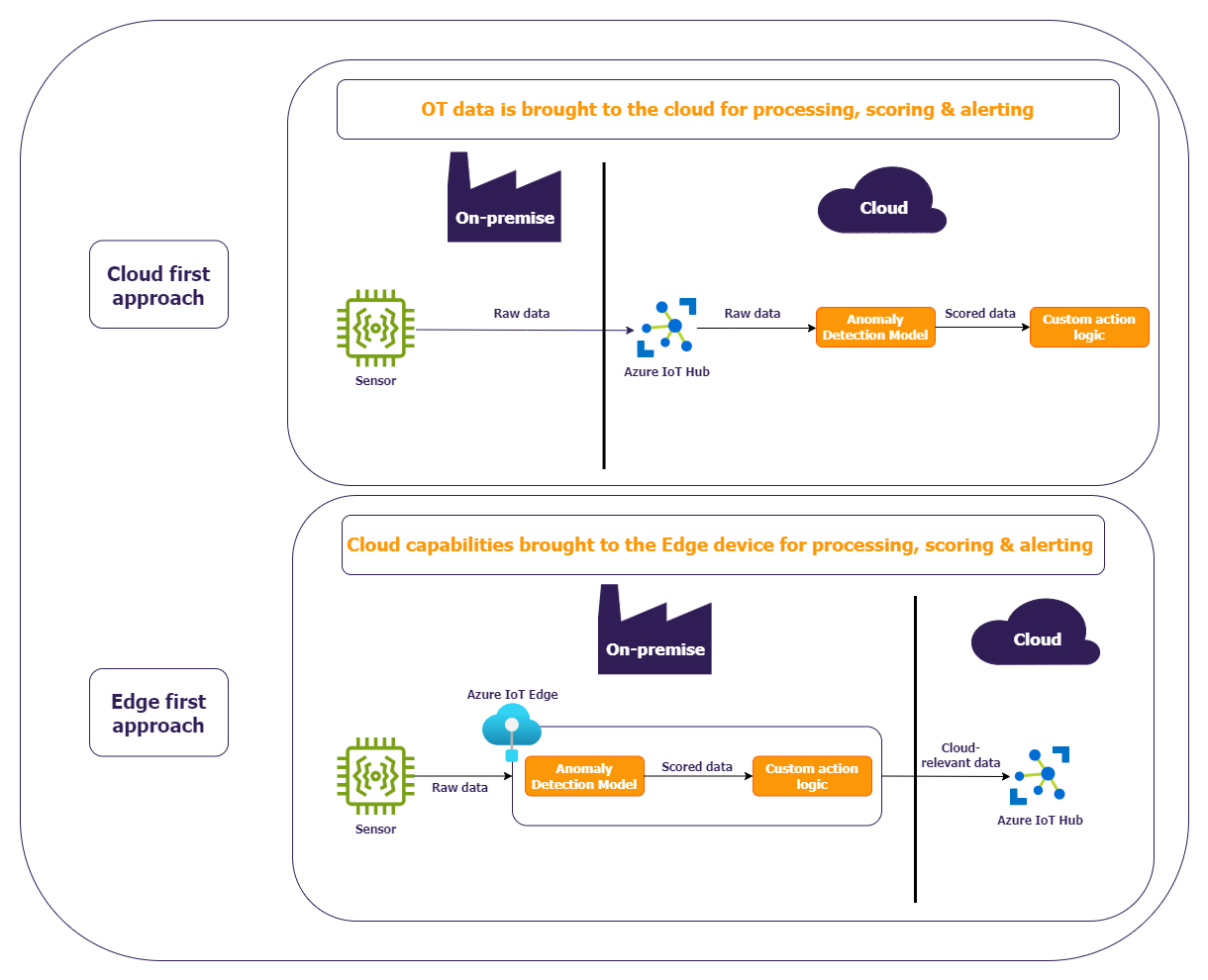OT and IoT data streaming is increasing in a manufacturing company's day-to-day operations. Typically, these data streams are set up in a cloud infrastructure, enabling a broad range of Analytics use cases in batch and in real-time. This article does not want you to imagine life without these cloud streaming patterns but introduces you to applying cloud capabilities to on-prem devices by executing streaming workloads "on edge". In this context, Azure IoT Edge can be the significant enabler for a new life, as you may already know: cloud life on the edge device.
What is Azure IoT Edge?
According to Microsoft, Azure IoT Edge is a device-focused runtime that enables you to deploy, run, and monitor containerized Linux workloads on your edge devices. It allows you to bring the analytical power of the Azure cloud closer to your edge devices to drive better business insights and enable offline decision-making. In traditional IoT setups, we often use Azure IoT Hub to register devices and enable data flows to the cloud for analysis. With edge devices, however, we allow local data processing on IoT devices or nearby gateways. This means you can think of IoT Edge as extending the traditional IoT setup by bringing the power of the cloud to the device itself.
What makes up Azure IoT Edge?
Azure IoT Edge consists of 3 main components to enable cloud capabilities on edge devices:
- IoT Edge Modules: The custom building blocks. These blocks are the units of execution containing custom logic that are run locally on your edge device. These containers can run Azure services, 3rd-party services, or your custom code. Modules can communicate with each other and thus can create your orchestration of actions on your edge device.
- IoT Edge Runtime: The orchestrator and communicator block. This multi-functional block enables the custom logic and manages communication from other edge devices to your edge device or from your edge device to the cloud, as well as the local communication between the IoT Edge Modules.
- Cloud-based interface: The visualization block. This gives you insight into your edge devices and lets you manage and monitor them from an intuitive UI.
What are the capabilities of Azure IoT Edge?
The cool thing about Azure IoT Edge is that it is capable of everything Azure offers in the cloud, but it is only on-prem locally on your device. If you can think of it, you can package it into a container and thus deploy it to your edge device. Let's highlight a few of the main capabilities that Azure IoT Edge is offering:
- Enabling communication from on-prem edge devices to the cloud (for devices that cannot directly communicate with the cloud themselves)
- Preprocessing messages from your edge device before sending them to the cloud
- Processing sensitive data only once on the edge
- Running Machine Learning models on your edge device locally
- Real-time (custom) alerting and monitoring on edge devices
- Store data locally in blob storage for edge devices with limited connectivity
Why would you choose Azure IoT Edge?
Reduce latency
Traditional IoT setups first send data from devices to the cloud, where it is processed and action taken. Although this data transfer is becoming faster and faster in modern data platform setups, it still causes latency that can be avoided by bringing this processing and action logic to the edge device itself. There are numerous cases in which this reduced latency could come in handy, and anomaly detection could be an enlightening example to illustrate this.
The main goal of anomaly detection is to detect deviant patterns consistently and on time. We often train and run the anomaly detection model in the cloud to ensure these patterns are detected consistently. Here lies room for improvement to enable earlier warnings: rather than keeping your anomaly detection model in the cloud, you could deploy it on edge and make the inference on your edge device. As a result, you can detect anomalies straight at the source and receive a warning with the least latency possible. The cool thing is that you can couple it to custom actions via Azure Functions, such as sending a mail notification based on the detected anomalies to execute a complete action plan with close to no latency at the edge.
Below, you can find a simplified visual that illustrates anomaly detection on OT data and compares a cloud-first approach with the edge-first approach. As the diagram shows, in the edge-first approach, the computer is brought closer to the data and, therefore, causes the least amount of latency for anomaly detection, causing your custom alerting or action logic to be executed faster.

Bypass network bandwidth limits
Thinking about IoT data means thinking about vast amounts of data streaming. This endless stream brings enormous consequences that we need to consider for the scalability and durability of our data architecture, infrastructure, and solutions. One of the constraints every organization faces is the fact that resources are limited. Network bandwidth is one of those limited resources that become more important when sending thousands of messages per second. The network bandwidth determines the upper bound of the data stream that can go from your devices to the cloud, whereby the amount and size of your messages per time interval are the determining factors of your streaming throughput. Azure IoT Edge can provide crucial help by compacting these determining factors: you can deploy a filtering module to your IoT Edge device to cap the number of messages sent to the cloud and the size of these messages.
Guarantee security compliance
The above points focus on the growing data that all manufacturing companies face. One of the new challenges is that we also see an increase in sensitive data. This data provides a competitive edge to organizations (pun intended) or comprises very personal data that needs to comply with strict processing legislation. Again, Azure IoT Edge can offer the solution by making it possible to process the data once at the edge device, which collects and deletes it after processing. Thus, only processed, non-sensitive data reaches the cloud, and the sensitive data is deleted after its collection in real-time. By doing this, we make sure compliance is met while still allowing for further analysis.
Conclusion
During all the research on Azure IoT Edge, I found this quote online about living on the edge: 'If you are not living life on the edge, you are taking up too much space', and I found this to be an ideal summary for Azure IoT Edge. By utilizing Azure IoT Edge, you can bring the power of the cloud to your on-prem devices and reduce the latency with which you are processing OT data, but also reduce the amount and size of your OT data for further processing on your cloud platform. Thus, Azure IoT Edge can form your architecture's foundation by performing your traditional IoT tasks optimally. It can also create the stepping stones for new use cases driven by cloud capabilities and advanced analytics on your edge devices.



